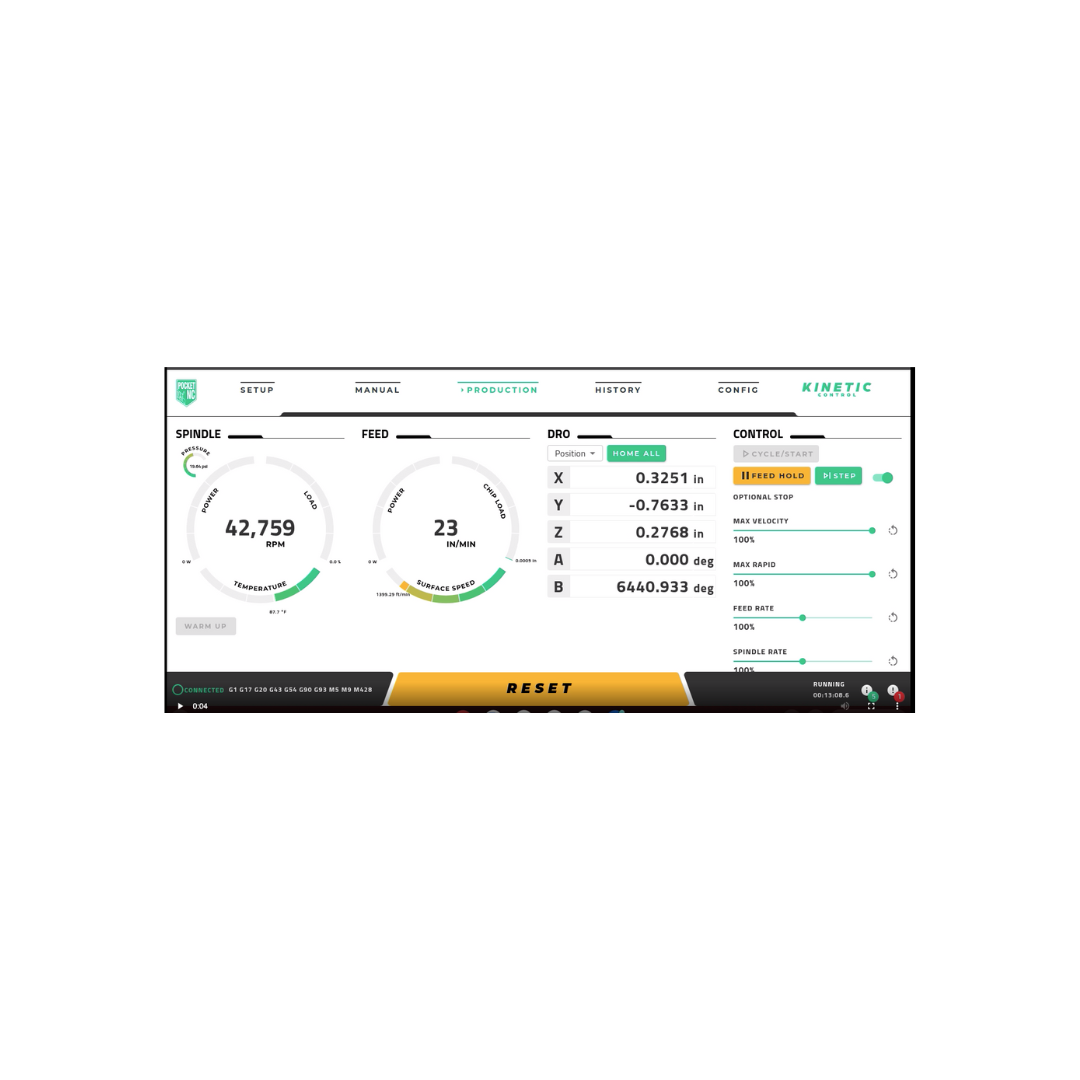Kinetic Control
Modern, intuitive UI and simulator with integrated 3D digital twin.
Penta Machine Company’s Kinetic Control software represents a revolutionary, human-focused approach to CNC user interfacing.
Tool center point control (TCPC)
Simple, intuitive user experience and sleek, modern graphics
Tablet- and laptop-compatible
Improved rotary axis
Additional program space for future versions and updates
What is tool center point control (TCPC)?
Tool Center Point Control (TCPC) allows a part to be programmed around a specific point on the part, rather than the center of rotation of the machine. This allows a machinist to touch off a point on their stock, store it in a G5x offset, and the machine will properly calculate how that position is rotated in space when the rotary axes move. TCPC makes programming significantly more intuitive.
TCPC is also an industry standard in 5-axis machining centers. Teaching future machinists through exposure to TCPC provides students with a broader skillset that is highly desirable to future employers.
KINETIC CONTROL CUSTOMER FEEDBACK
FREQUENTLY ASKED QUESTIONS
-
The Kinetic Control user interface is built using HTML, JavaScript and CSS, the building blocks of the web. This allows the user interface to be viewed and interacted with on any device that has a web-browser, such as your phone, tablet, laptop or desktop when connected via USB or Ethernet. Kinetic Control does not need to be connected to the internet to function, and only interacts with our servers if the user wants to update over the network. Alternative update mechanisms are possible that don’t require connecting the machine to the network. Contact service@pentamachine.com for more information.
-
No, Kinetic Control’s UI is served directly from your machine to your connected device either over USB or if desired over a connected Ethernet cable. No network traffic goes out to the cloud, unless you specifically wish to update your software. If you cannot connect your machine to the network (due to any reason from organizational policies to physical constraints), there are alternative ways to update. Reach out to service@pentamachine.com for more information. See here for more information about updating Kinetic Control via the network.
-
Rotated Work Offsets is similar to TCPC, but is only for 3+2 machining. It allows for a part to be programmed around a specific point on your stock, similar to TCPC, but no simultaneous rotary moves should be performed after enabling RWO. Using RWO rather than TCPC for 3+2 machining allows X, Y and Z G-code moves to perform physical moves of the corresponding X, Y and Z axes. In TCPC, on the other hand, since the X, Y and Z G-code moves are relative to the part, the physical axes that will move may not be the same.
-
Industry standard: TCPC is commonly used for industrial applications in 5-axis machining centers. This type of programming is more accessible to those already familiar with 5-axis machines. If students are learning 5-axis machining on the Pocket NC TCPC will be another skillset they can add.
Ease of programming and setup: Without TCPC, offsets on the linear axes wouldn’t have any meaning after moving either of the rotary axes. That means, prior to having TCPC and RWO, parts had to be programmed around the center of rotation of the machine. This requires having fairly precise work holding solutions. TCPC and RWO provide more flexibility for the operator when mounting stock as the same program can be used when mounting a part in a different location on the machine, as long as a point on the stock is adequately located.
-
Current available posts include Fusion 360, HSM Works and Siemens NX CAM. Mastercam is in process. Mecsoft (Rhinocam) has a post available, but will charge. You can still use the old posts and program around the center of rotation. Up-to-date post information can be found here.
-
Please reference the Kinetic Control Software Overview, Getting Started video series, Online Course, and Written Tutorials. Please direct any questions to service@pocketnc.com.
-
Machines shipped in 2022 and later will ship with Kinetic Control installed. You do not need to purchase the SD card separately.
If you are a current V2 series machine customer you can purchase the new user interface on an SD card here. Moving forward there are no subscription or update fees for the software and we will publish updates and changes to the Pocket NC Software Versions here. The updating process is easy and integrated into the user interface.
Want more information about Kinetic Control?
-
Webinar Walkthrough
Explore our webinar walkthrough for the software and applications teams.
-
Get in touch
Contact our team to discuss how our CNC machines can support your students.

